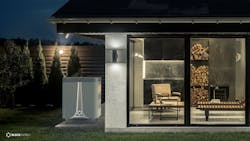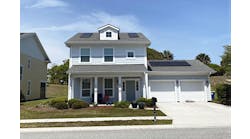The Housing Initiative Partnership (HIP), Emera Technologies and Pepco are moving ahead on a residential microgrid project at a subdivision of net-zero, low-to-moderate income houses with the support of a $200,000 grant from the Maryland Energy Administration (MEA).
The grant will support a community solar and battery energy storage system as well as the related racking, mounting and wiring equipment for six homes in Fairmount Heights, Maryland.
The project will use Emera Technologies’ plug-and-play residential microgrid system called BlockEnergy, which allows homes to share combined renewable generation. The community microgrid system also provides reliability and resiliency for the neighborhood, according to the MEA.
Learn more about Maryland’s microgrid program at Microgrid 2021 where Brandon Bowser from the Maryland Energy Administration will participate in a special session: “Microgrids that Foretell the Future.” Registration is free if done in advance. Space is limited on the platform.
“The BlockEnergy microgrid is a utility-focused system that easily scales to meet new residential growth and gives utilities the ability to manage distributed community energy with a single point of control,” Rob Bennett, Emera Technologies CEO, said April 29.
The microgrid will include homes that meet the US Department of Energy’s Zero Ready Energy standards and the Passive House Institute’s PHIUS+ 2018 certification standard for highly efficient passive houses.
Pooling the project’s solar resources in a microgrid, instead of installing solar panels on each house and tying them to the grid, could bring initial investment costs down and drive efficiency of energy generation up, according to Peabody & Fine Architects, HIP’s architect.
HIP, a nonprofit, green, affordable housing developer, expects to break ground on the first phase of the development in the fall. The housing developer will market the homes to first-time homebuyers earning 80% or less of the area median income.
Under a three-year pilot project, Pepco, a Washington, DC-based utility, will collect data for specific metrics related to the microgrid and its potential benefits to the distribution system.
Pepco said it will share the details on the design, goals, proposed metrics and timeline associated with the pilot project with the Maryland Public Service Commission, community members and the public later this year.
Project provides model for other microgrids
The Fairmount Heights Net Zero community will serve as a model for wide-scale adoption across Maryland, according to the MEA.
“Supporting the development of new and affordable clean energy homes for first-time, low-to-moderate income home buyers is a sustainable model Maryland can build upon,” Maryland Gov. Larry Hogan said.
Peabody & Fine Architects said the project is a model for “a future community-centric, distributed energy grid.”
Last year, the pilot project received $100,000 in funding for its design phase through the MEA’s Resilient Maryland program.
Track news about residential microgrid projects. Subscribe to the free Microgrid Knowledge Newsletter.







